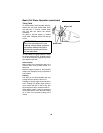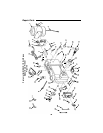
29
Safety Instructions for Basic Drill Press Operation
Read the following instructions for
operating your drill press to get the
best results and to minimize the likeli-
hood of personal injury.
WARNING: For your own safety,
always observe the safety precau-
tions here and on pages 2 thru 6.
Plan Ahead To Protect Your Eyes, Hands, Face and Ears
Dress for safety
• Do not wear loose clothing, gloves,
neckties or jewelry (rings, wrist
watches). They can get caught and
draw you into moving parts.
• Wear nonslip footwear.
• Tie back long hair.
• Roll long sleeves above the elbow.
• Noise levels vary widely. To reduce
the risk of possible hearing damage,
wear ear plugs or muffs when using
drill press for hours at a time.
Plan Your Work
• Don’t force the tool. It will do the job
better and safer at the rate for which
it was designed.
• Use the right tool. Don’t force tool or
attachment to do a job it was not
designed to do.
• If any part of your drill press is miss-
ing, malfunctioning, has been dam-
aged or broken...such as the motor
switch, or other operating control, a
guard, safety device or the power
cord, turn the drill press off and
unplug it until the particular part is
properly repaired or replaced.
• Never place your fingers in a posi-
tion where they could contact the
drill or other cutting tool if the work-
piece should unexpectedly shift or
your hand should slip.
• To reduce the risk of injury from
parts thrown by the spring, follow
instructions exactly as given and
shown in adjusting spring tension
of quill.
• To prevent the workpiece from being
torn from your hands, spinning of
the tool, shattering the tool or being
thrown, always properly support
your work so it won’t shift or bind on
the tool:
- Always position backup material
(use beneath the workpiece) to
contact the left side of the column.
- Whenever possible, position the
workpiece to contact the left side of
the column - If it is too short or the
table is tilted, clamp solidly to the
table. Use table slots or clamping
ledge around the outside edge of
the table.
- When using a drill press vise,
always fasten it to a table.
- Never do any work “Freehand”
(hand holding workpiece rather
than supporting it on the table),
except when polishing.
- Securely lock head to column,
table support to column and table
to table support before operating
drill press.
- Never move the head or table
while the tool is running.
- Before starting the operation, jog
the motor switch to make sure the
drill or other cutting tool does not
wobble or cause vibration.
- If a workpiece overhangs the table
such that it will fall or tip if not held,
clamp it to the table or provide aux-
iliary support.
- Use fixtures for unusual operations
to adequately hold, guide and posi-
tion workpiece.


















